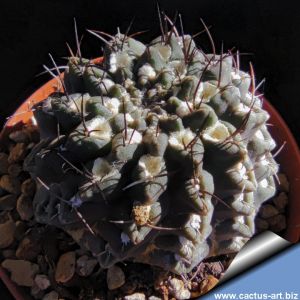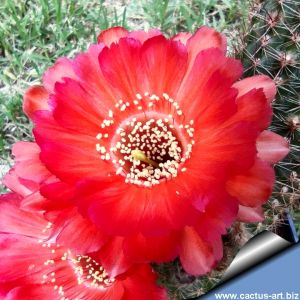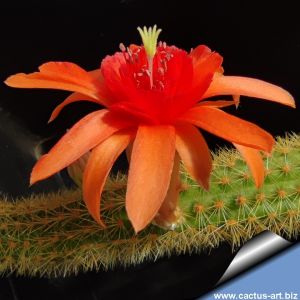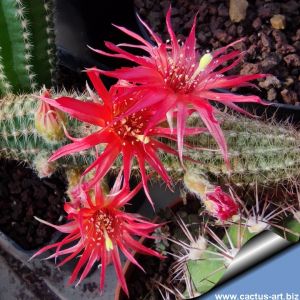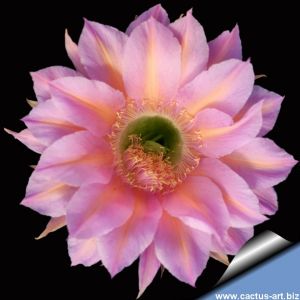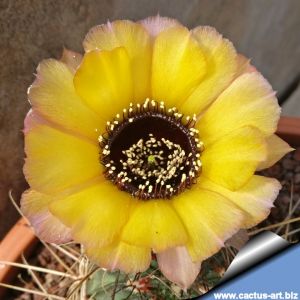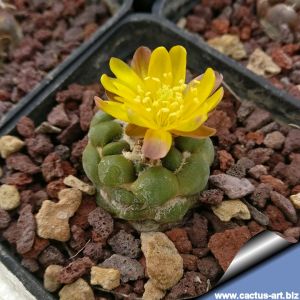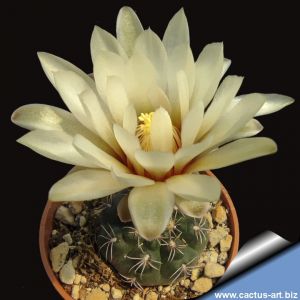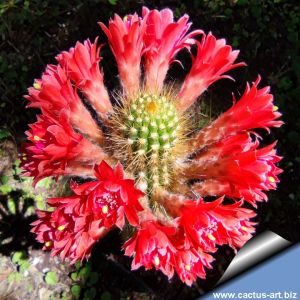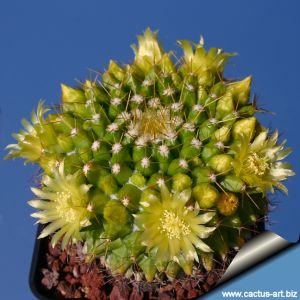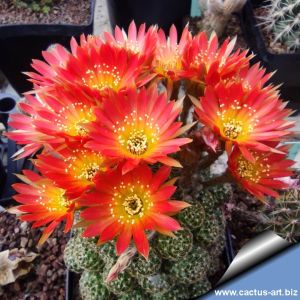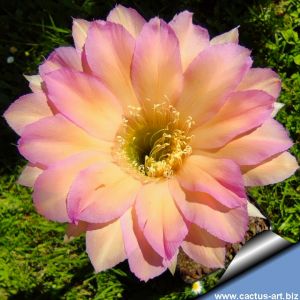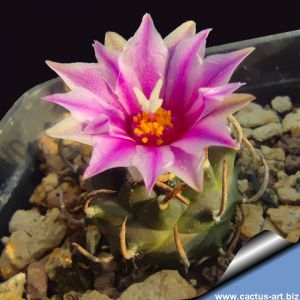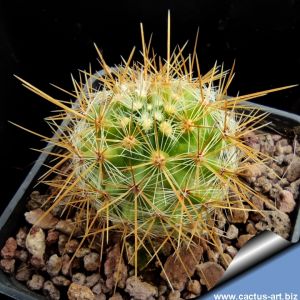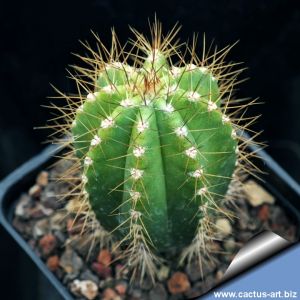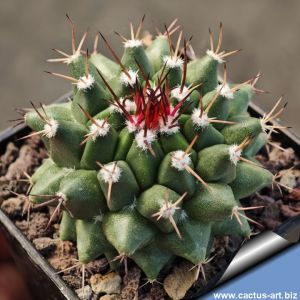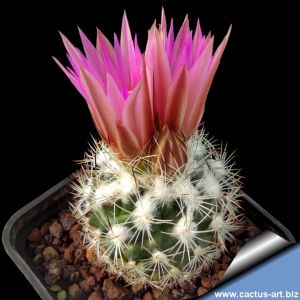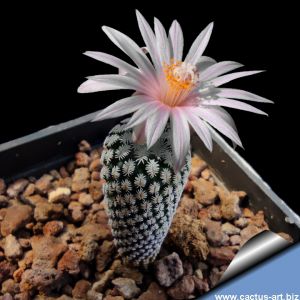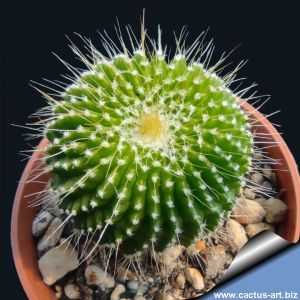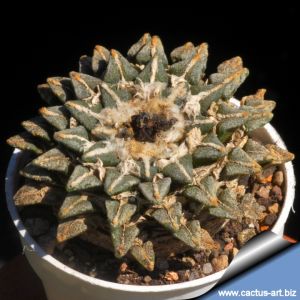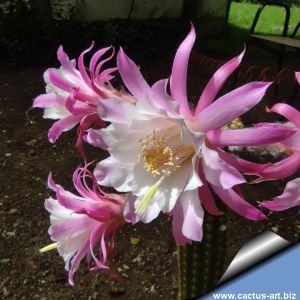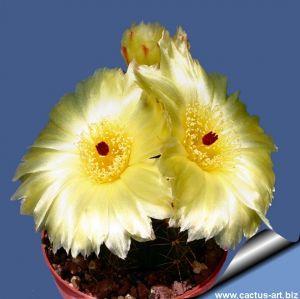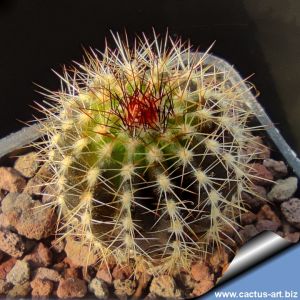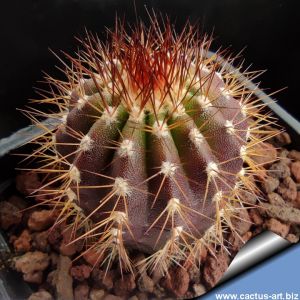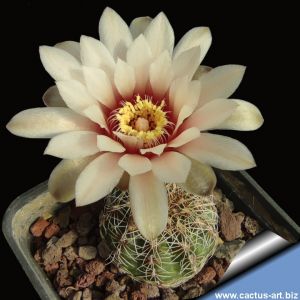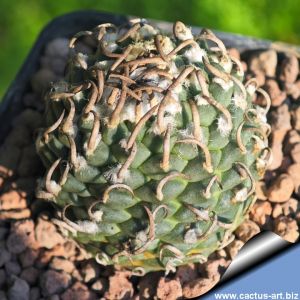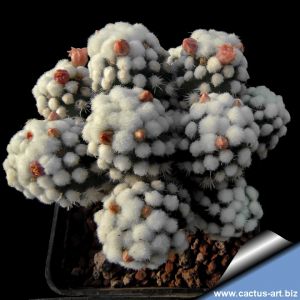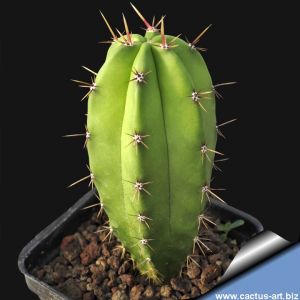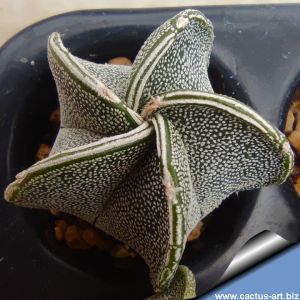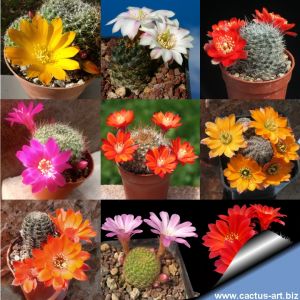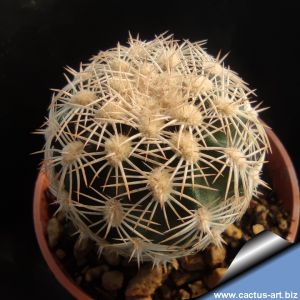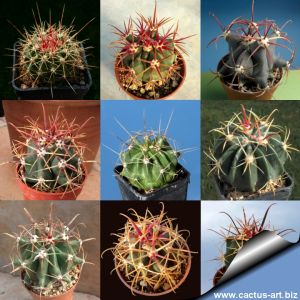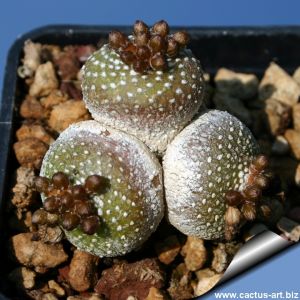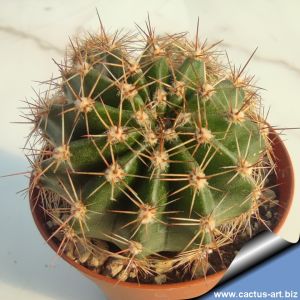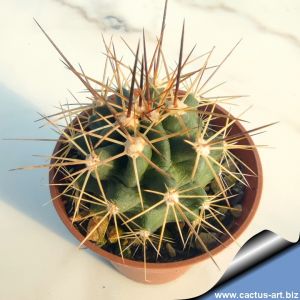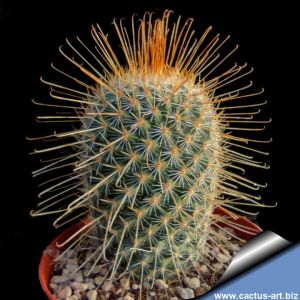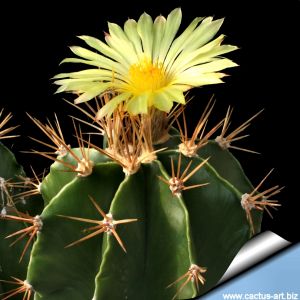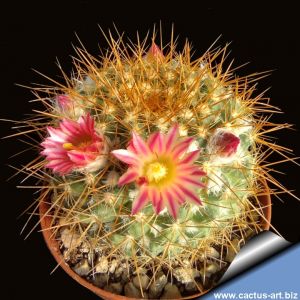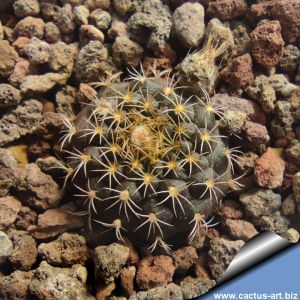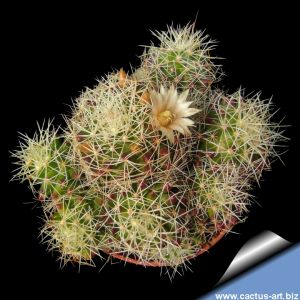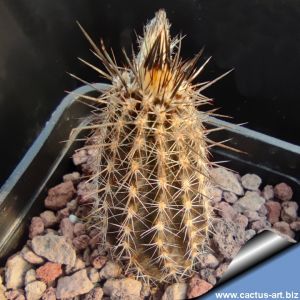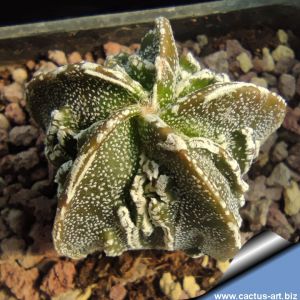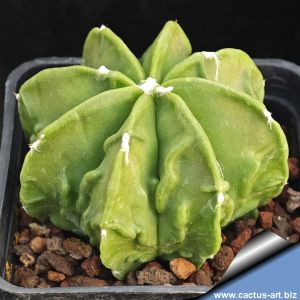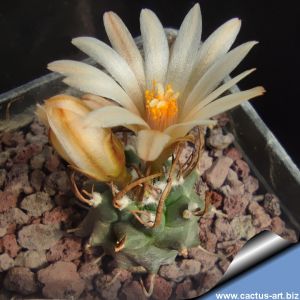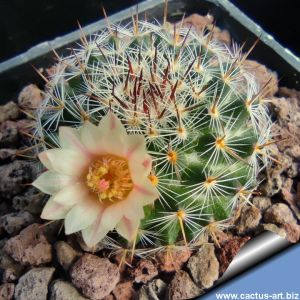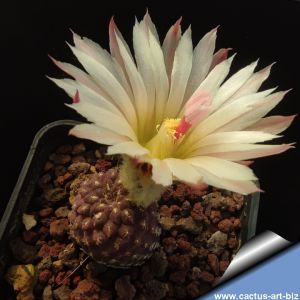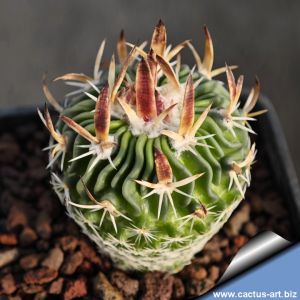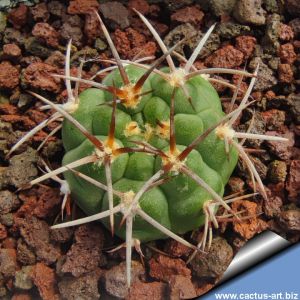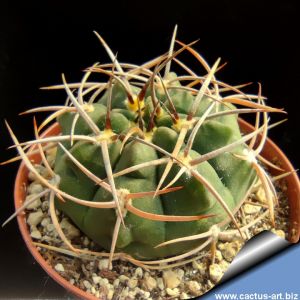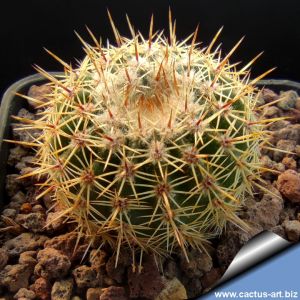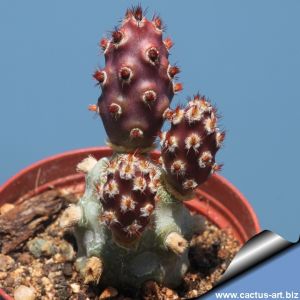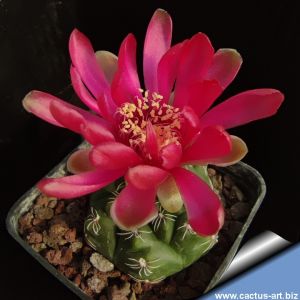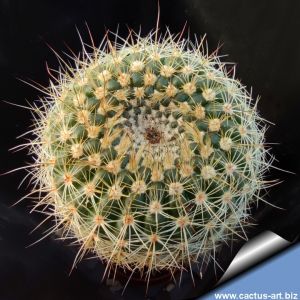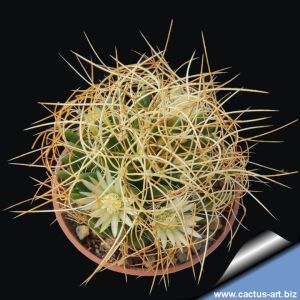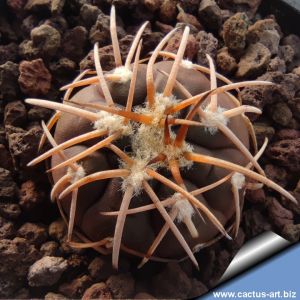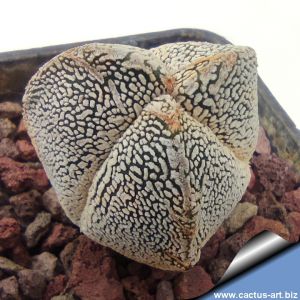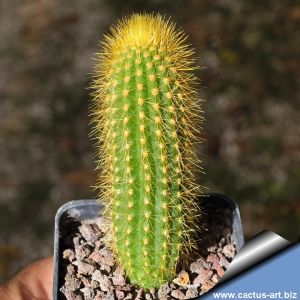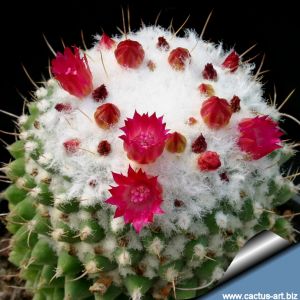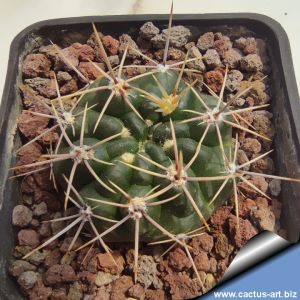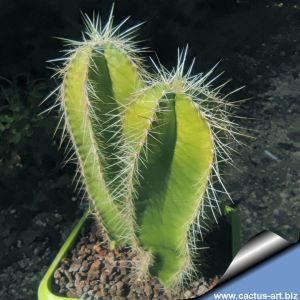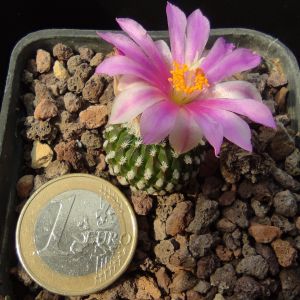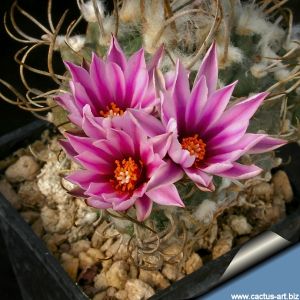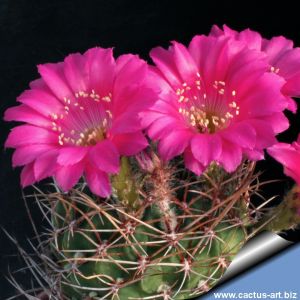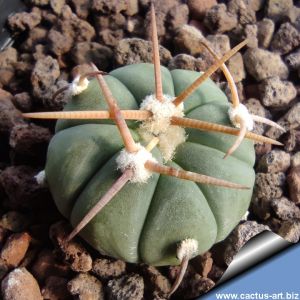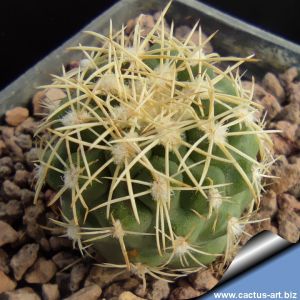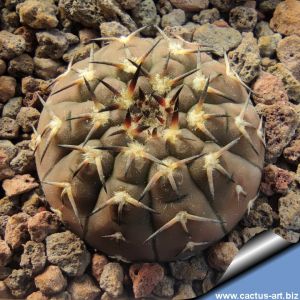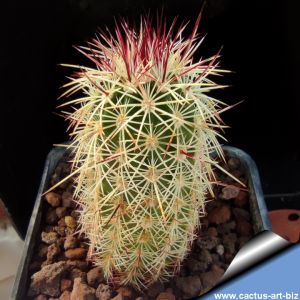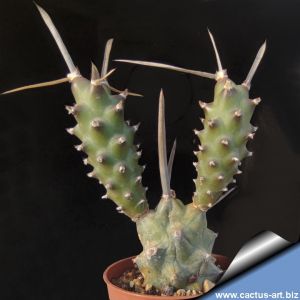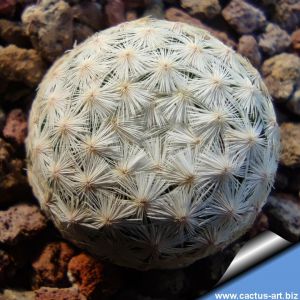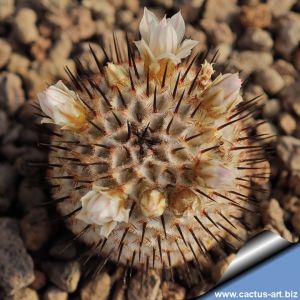-
1
A small-growing plant with a low stem, spineless or shortly spiny, in dark purple to nearly black tones. Flat, solitary, mostly underground, and supported by a tuberous root.
-
2
Chamaelobivia cv. ESP 2009.40.2 hybrid (Chamaecereus Granat x Lobivia claeysiana)
-
3
Beautiful cultivar with thin stems and two-tone flowers with light orange and carmine-orange petals.
-
4
-
5
-
6
This is a selected clone of Lobivia jajoiana. The yellow petals have lilac shaded edges. The hymen (or throat ring of the flower) is always of a very dark purple to black.
-
7
A tiny geophytic cactus with an olive-green spherical stem marked by smooth, rounded tubercles. Its sunken woolly areoles lack spines. A deep tuberous root anchors the plant. Bright yellow flowers, larger than the stem, emerge at the apex.
-
8
Flattened spherical body, olive-green or dark gray-green. White areoles with short, appressed spines pointing downward. Large cream-colored flowers with red throats, produced abundantly even on young plants.
-
9
"RED HILDE" is an extremely floriferous hybrid with red flowers produced at the tips of the branches. It blooms repeatedly from spring until the end of summer.
-
10
-
11
Exceptionally vivid, showy flowers with elongated red-orange petals and a brilliant yellow throat create a fiery contrast. Blooms appear abundantly and simultaneously, forming luminous clusters that cover the entire plant.
-
12
-
13
Syn: Turbinicarpus schmiedickeanus v. rubriflorus
-
14
Pretty with long yellowish spines.
-
15
Only few ribs, green-blue body, yellow to brown spines.
-
16
Mammillaria polyedra is a low growing cactus, solitary at first, later branching to form colonies or cushions. Flower pink or reddish.
-
17
-
18
Initially bearing only short white pectinated spines, it matures into producing long twisted central spines. Early blooming, even young plants display beautiful cream flowers with pink striping.
-
19
NEW. Selected form with only one or few bristly spines per areole.
-
20
A star-shaped disk that lives half-buried! It forms flat, geometric rosettes no larger than a coin and hides a long, fleshy taproot underground. A gem for lovers of camouflaged, minimalist plants.
-
21
-
22
Under intense light or cold, the skin develops vivid red-purple hues. Its broad yellow blooms have a unique silky brightness that enhances the plant’s ornamental appeal.
-
23
This is the Uebelmannia population found at the highest-elevation locality of the genus (1415 m), thriving in rocky highland environments with slightly cooler conditions than typical for the species.
-
24
The southernmost known population of Uebelmannia grows at an elevation of 1220 m, thriving in rocky highland environments with slightly cooler conditions than typical for the species.
-
25
Short cylindrical stems with many dirty white spines, dark body, white-pink flower with reddish throat.
-
26
Piante minuscole (max 20-35 mm), con tubercoli piramidali a 4 spigoli, verde glauco a ocra. Radice napiforme. Spina singola, cartacea con cuticola screpolata, e curva verso l'apice della pianta. Fiori bianchi con venatura centrale rosa o magenta pallido.
-
27
-
28
Heliabravoa chende is a large candelabra like cactusr, olive green body, later up to 3(–5) m tall. The flowers are white.
-
29
The Japanese HAKU-JO cultivar features fuzzy areoles along its ribs, forming a double felt line that makes it appear as though the areoles are linked together.
-
30
A captivating mix of Rebutia, featuring various species, hybrids, and seed-grown cultivars. Each plant is one-of-a-kind, with unique shapes, spination, and flower colors.
-
31
E. pectinatus v. ctenoides is a cylindrical Echinocereus species related to E. dasyacanthus.The stems are banded with pink and grey as in the rainbow cactus (E. rigidissimus). The flowers are yellow, orange and very large for the size of the plant.
-
32
Mix of Ferocactus, featuring various species, hybrids, and seed-grown cultivars. Each plant is one-of-a-kind, with unique shapes, spination, and flower colors.
-
33
The fechseri is a sturdy variant, with olive-green stems roughly double the size of Blossfeldia liliputana, adorned with white areoles. Its flowers are creamy-white inside and reddish-purple on the exterior. SEEDLING 1,2-1,5 cm Ø.
-
34
-
35
Clumping cactus forming large dense clusters. Funnel-shaped bright orange-red flowers emerge near stem tips. Remarkably winter hardy - for rock gardens or container cultivation in cold climates.
-
36
Selected form with very long yellow spines, pink flowers, very beautiful species!
-
37
-
38
Areoles with dense white wool, axils with very dense white wool and numerous long white bristles. Spines heavy orange-yellow to reddish. Seldom seen in cultivation. Very nice.
-
39
Among globular Frailea, F. pumila is one of the largest, growing up to 5 cm wide. Its pubescent spines, 1-5 mm long, are yellow-brown and hard to classify as centrals or radials.
-
40
-
41
-
42
Rare variety that combines the irregular ribs of FUKURYU with the felt lines of HAKU-JO on the edge of the ribs. As the plants get older they become more and more beautiful.
-
43
(HEKIRAN FUKURYU Type B + RURI KABUTO) Distinguished by unique supplemental rib structures and naked body without dots.
"multicostatum" = 6-7 (or more) ribs.
-
44
Tiny grey tubercled body with upward-curving corky spines. Cream-colored flowers. A miniature treasure.
-
45
Mammillaria chionocephala is an attractive globose pincushion cactus with white to rose-red flowers, in a circle near the summit.
-
46
The horrida variety is greener than the type, with firm lizard-skin-like texture and more spreading spines (lacking the comb effect). Color adapts to light: green in shade, purple in full sun.
-
47
-
48
Beautiful plant which over time forms flattened, very wide central spines curved towards the centre. Very impressive and different. An impressive feature that becomes
more dramatic with age.
-
49
Beautiful species with dark green body. Few stout, slightly bent spines. Bears short red flowers, striking despite their size.
-
50
Curly think spines.
-
51
Unlike most Notocactus (which almost always have yellow flowers), this species bears blooms ranging from creamy yellow to lavender. Spines vary from yellowish-white to red-brown.
-
52
Beautiful and rare variety with deep purple new shoots. Over time, the shoots become covered with a gray pruinous patina which gives them a very characteristic appearance. Seldom offered for sale.
-
53
Red flowers.
-
54
Globose, dark green stem flattened at the top, adorned with whitish or beige spines. Blooms repeatedly in summer with yellow flowers 4–6 cm in diameter.
-
55
Long twisted cream colored spines form an intricate nest-like pattern on top.
-
56
Special selection. Stunning spines, long and elegantly bent downward. One of the most beautiful forms available.
-
57
A rare Astrophytum cultivar combining a three-ribbed (tricostate) form with dense, irregular white flecking (ONZUKA pattern) . A special plant highly sought after by collectors for its clean, sculptural look. Each specimen has a unique pattern.
-
58
Columnar, shrub-like cactus native to the dry valleys and rocky slopes of Peru. Its blue-green stem can reach up to 2 meters in cultivation, bearing dense spines in pale yellow, golden, or yellow-brown hues. Slow-growing and cold-sensitive.
-
59
A distinctive and highly attractive cultivar with little to no spines. Elongated tubercles are topped with brilliant white wool, contrasting beautifully with vivid deep pink flowers. Looks like a fluffy, elegant plush toy.
-
60
Very big light yellow flower!
-
61
Large candelabra-like cactus, often tree-like, 6 high, with a well-defined woody trunk. Isolatocereus dumortieri was also known as Cereus, Lemaireocereus, Stenocereus. Young plants frequently exhibit mesmerizing spiral ribbing.
-
62
Flowering size.
-
63
Dazzling blooms in hot pink, each petal marked by a sharp purple midline. A jaw-dropping color, Absolutely breathtaking!
-
64
Flat green body crowned with shiny violet flowers. Thriving in the harsh conditions of the Andes mountains, it remarkably withstands freezing temperatures.
-
65
-
66
Globose grey-green to grey-blue stem with a flattened apex, typically 8 ribs and circular areoles. Creamy wool shields the growing tip. Strongly recurved, subulate, somewhat flattened spines in pink, grey, tan, or brown leave the stem surface visible.
-
67
Grafted on very cold resistant Echinocereus.
-
68
Very flattened chocolate brown body. Three short spines per areole appressed to the stem. Very nice but slow growing.
-
69
-
70
-
71
A tiny cactus resembling a golf ball, densely covered in appressed white spines. Its flowers are remarkably large for a Mammillaria—vivid pink-purple and highly showy.
-
72
Mammillaria perezdelarosae ssp. andersoniana is a marvellous tiny cactus distinguishable from the standard species for its smaller size, slower growth and straight central spines (not hooked). It is believed to be one of the most beautiful Mammillaria.

